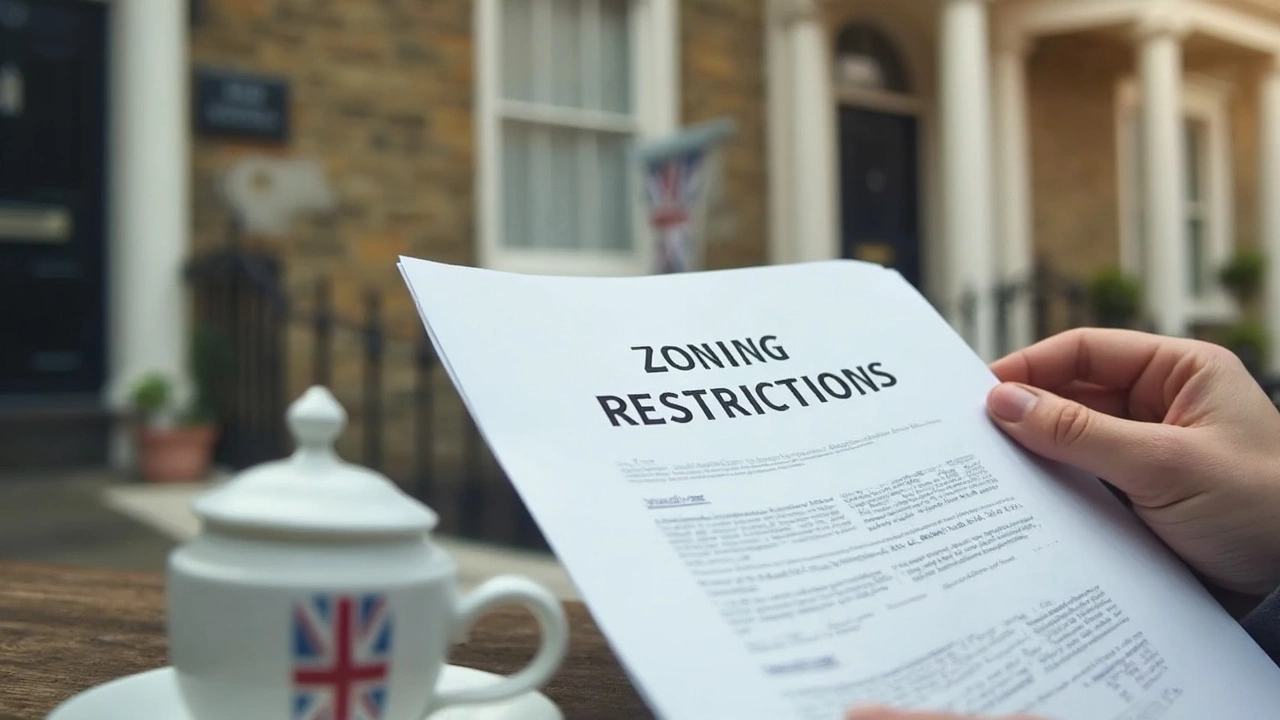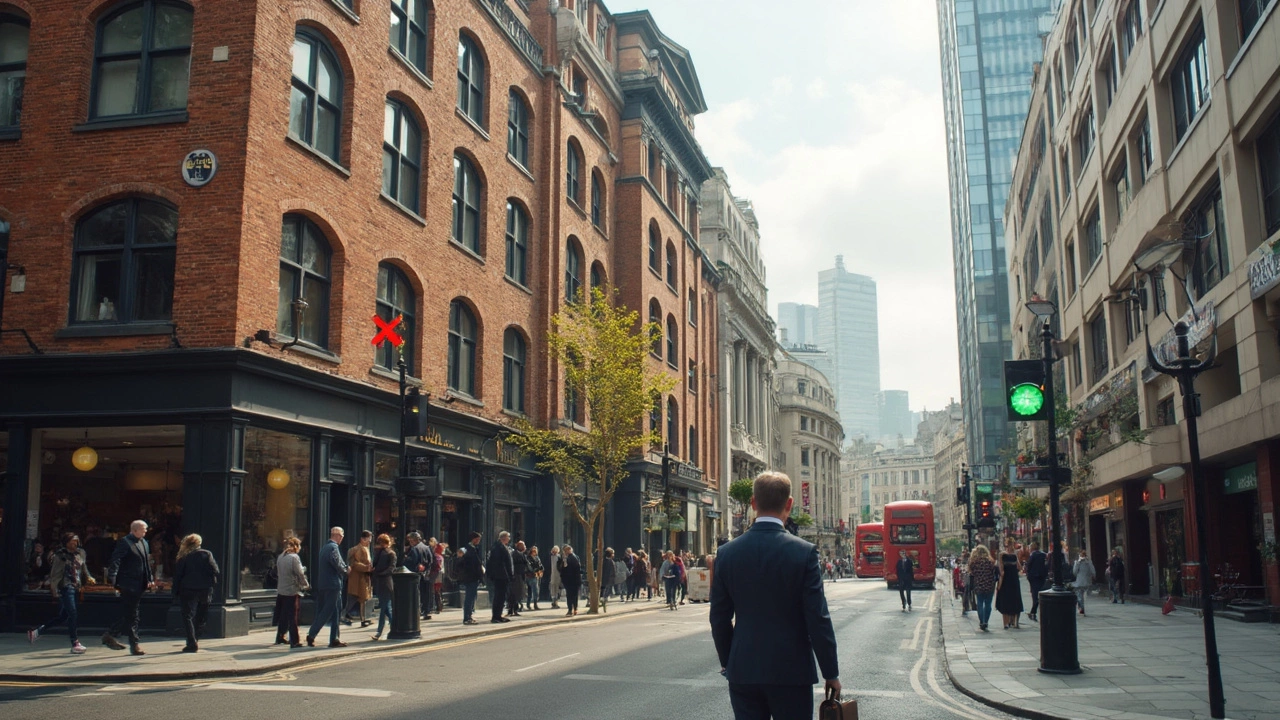Ever spotted the perfect building but found out it couldn’t be used for your business? Happens more than you’d think. Many spots that look great for a shop, office, or warehouse are locked out by local rules, property agreements, or even weird utility setups.
Understanding what’s considered “not for commercial use” can save you piles of cash and endless headaches. Zoning laws can flat-out deny business activities in certain areas—even if your neighbors run a cake shop from their garage. Plus, some properties come with sneaky restrictions hidden deep in the paperwork you might not read carefully at first.
Some places even have rules baked into utility hookups—sharing power with residential users, for example, can be a total deal-breaker if you plan on heavy equipment or extended hours. The pitfall? Missing these limits can lead to fines, legal battles, or worst case, being forced to pack up before your project even takes off.
- Where the Lines Are Drawn
- Common Restrictions on Use
- Hidden Traps in Property Agreements
- Legal and Permit Pitfalls
- Quick Tips for Avoiding Expensive Mistakes
Where the Lines Are Drawn
If you want to use a property for business, figuring out if it’s allowed starts with one word: zoning. Zoning laws slice up cities and towns into zones like commercial, residential, or mixed-use. If you get this wrong, you’ll hit a wall before you even start. The commercial construction world is full of these headaches.
Every city or county’s got its own rulebook. Most post their zoning maps and codes online. For example, New York City zoning designates areas as C for commercial, R for residential, and M for manufacturing. It’s simple on paper, but some zones allow little overlap. You can’t just stick a furniture showroom in a strictly residential zone, no matter how good the location is.
- Commercial Zones (C): Designed for businesses—retail, restaurants, offices, and more.
- Residential Zones (R): Strictly for housing. Most businesses (even home offices) can get slapped with fines.
- Mixed-Use Zones (MU): A bit of both, but there are major limits. Barbershop might be fine, but a warehouse—definitely not.
- Industrial Zones (I): For factories, warehouses, or very heavy-duty stuff.
Check out this snapshot of how zoning breaks down in a real city. It’ll save you from wishful thinking:
| Zone Type | Examples Allowed | Not Allowed |
|---|---|---|
| Commercial (C) | Shops, Cafes, Offices | Single-family Homes |
| Residential (R) | Houses, Apartments | Retail, Warehouses |
| Mixed-Use (MU) | Ground-floor Store with Apartments Above | Heavy Manufacturing |
| Industrial (I) | Factories, Logistics Hubs | Daycares, Offices |
Zoning is where folks trip up most. If you already own a place, never assume you can switch its use. If you’re eyeing a new spot, double-check the zoning before you spend a penny or sign anything. Cities rarely make exceptions—getting approval for a variance is possible, but it takes months and there’s no guarantee. So, save yourself some grief and check first.
Common Restrictions on Use
This is where the headaches usually start. Even if a property looks ready for business, there’s a pile of rules on what you can—and can’t—do with it. Commercial construction projects have to clear a bunch of hurdles before you can even move in a desk.
The big one? Zoning laws. Every city slices up neighborhoods into zones—residential, commercial, industrial, and more. If you try to set up shop in a residential zone, expect pushback or outright rejection. Some cities are ruthless about this. For example, in Los Angeles, just 6% of city land is zoned for commercial use. That’s not a lot to work with.
But zoning isn’t the only thing stopping you. Here are some red flags that mean “not for commercial use”:
- HOA or building covenants: Some communities have homeowner associations or deed restrictions that ban businesses completely—even hair salons or small offices at home. Always read the fine print.
- Parking requirements: Cities often require a minimum number of parking spots per square foot of business space. Short on parking? No approval.
- Historic status: A spot on the historic register might mean you can’t remodel, put up signs, or change the outside look at all. Good luck turning that beautiful building into a modern restaurant.
- Environmental/protection zones: Wetlands, flood zones, or protected land often ban any kind of commercial activity. You can’t build there, even if you own the dirt.
- Utility limitations: Some properties just can’t handle the utility load needed for modern businesses. Water, sewage, and electric capacity get capped, especially in older neighborhoods.
It helps to see how these rules shape what you can do. Check out this table for a quick look at common restrictions by type and their typical impact on commercial projects:
| Type of Restriction | Typical Effect | Who Sets the Rule? |
|---|---|---|
| Zoning laws | Blocks commercial operations in non-commercial zones | City or County Government |
| HOA/Deed restrictions | Bans almost all business activity | Homeowner Associations/Developers |
| Parking regulations | Denies permit if you lack enough parking | Local Planning Departments |
| Historic landmark rules | Stops major renovations or modern business use | Historic Commissions |
| Environmental zones | Outlaws any new commercial construction | City, State, or Federal Authorities |
| Utility restrictions | Limits heavy equipment or high water/electric use | Utility Providers/Local Code |
Missing one of these? Your permits freeze or never get off the ground. Winning in commercial construction means nailing down what’s legally possible—before you close the deal or sign a lease.

Hidden Traps in Property Agreements
Even if a property looks perfect for your project, getting tripped up by the fine print is way too easy. Property agreements can be loaded with clauses that quietly ban commercial construction or limit what you can really do there. These traps aren’t always front and center—they usually sit deep in leases, deeds, or HOA documents most folks skim over or ignore.
Here’s where things get sticky: covenants, conditions, and restrictions (CC&Rs). These can flat-out block running certain types of businesses, adding signs, or even parking work vehicles on site. Sometimes, an old agreement written decades ago still holds power, making the property a no-go zone for any business use no matter how much the market has changed.
Take a look at these common traps buried in property paperwork:
- Exclusive use clauses—another tenant or previous owner paid for exclusivity, so your business type is banned.
- Non-compete terms—blocks new businesses from competing with existing ones in the same property.
- Prohibited activities—can rule out daytime deliveries, specific trades, or even hours of operation.
- Parking and access—some agreements limit commercial vehicle size, delivery times, or even customer access routes.
- Signage restrictions—no loud signs, neon, or even logos over a certain size.
According to a 2023 survey by the National Association of Realtors, 39% of failed commercial projects were delayed or blocked due to overlooked property restrictions. Think you’re safe after scanning the contract? Not always.
| Property Trap | Typical Impact on Commercial Use |
|---|---|
| Exclusive Use Clause | Only one business type allowed; others are blocked outright |
| Parking Limits | Caps number and size of vehicles, hurting delivery or customer access |
| Signage Restriction | No large or lighted signage—hurts retail visibility |
| Prohibited Activities | Certain businesses, like food or auto repair, banned outright |
If you’re looking at a property for business, get a lawyer who knows commercial real estate. What seems like a tiny note could cost you big time later. Save yourself the trouble—dig deep into every agreement before you put down money or start any building work. Missing one of these traps is a classic way to waste a budget and months of your life.
Legal and Permit Pitfalls
This is where a lot of people trip up. Even if your property looks right for business, skipping legal checks or moving too fast with permits can ruin everything. Red tape is real in commercial construction. One missed step can lead to stop-work orders, surprise costs, or even court dates. Cities love forms, and no two towns are exactly alike, so don't assume what worked elsewhere will fly here.
Start with permits. Pretty much every city or county demands permits for commercial projects—even for what look like little jobs. No permit? You could face daily fines, or be forced to rip out work already done. If the job is commercial but you apply for a residential permit (maybe thinking you’ll save a buck), inspectors will spot it eventually. Then it gets messy.
Here’s something wild—sometimes the area might be zoned mixed-use, so you think you’re good. But if your business sells food, handles chemicals, or even just holds large events, there might be special health, fire, or environmental permits you never heard of. There are cities in Texas where even setting up a basic office in an old house needs ‘change of use’ paperwork filed first.
You’ll also run into stuff buried in old deeds or building covenants: clauses like "no retail activity allowed" or limits on business hours. Most people miss those because they’re hidden in thick property documents. Get a title search and read what you can—don’t just take the agent’s word for it.
- Check local zoning offices for what’s really allowed—don’t guess.
- Ask the city building department about every permit your business or remodel might need.
- Dig into the property history for any use restrictions or covenants.
- If you're unsure about any legal language, talk to a construction lawyer—it pays off.
One local Houston code official told me,
"About half our stop-work cases come from commercial jobs that never pulled the right permits or filed for a use review. That’s usually not a mistake—they’re just rolling the dice."That’s not a gamble worth taking. The upfront hassle beats having your new space chained up by inspectors before you even open the doors.

Quick Tips for Avoiding Expensive Mistakes
There’s no shortage of stories about folks fixing up a spot for a business, only to get slapped with fines or forced to leave. You don’t want to be that person. Here’s how to dodge the worst headaches in commercial construction.
- Check zoning maps first. Before you even sign a lease or make an offer, pull up your city or county’s zoning website. Most local governments have online maps so you can see exactly what’s allowed on a property.
- Inspect title deeds and property records. These documents often list restrictions that aren’t obvious—like “residential use only” or limits on commercial signage and parking.
- Ask about utility setups. Not all buildings have the right hookups for business needs. Many cities require special meters, wiring, or plumbing for commercial use. Missing this step is a classic money-waster.
- Don’t skip permit checks. Every change—new walls, signage, even paint colors—can trigger permit requirements. Your local planning office can give you a quick list or checklist for your project type.
- Speak to the neighbors. This one gets missed a lot. Not only can neighbors report violations, but some areas even give them power to block commercial permits if they object. A simple chat saves drama later.
Want some numbers? Here’s how much skipping these checks can cost on average in the U.S.:
| Mistake | Typical Fine/Cost |
|---|---|
| Operating without a valid permit | $2,500 - $7,500 |
| Breaking zoning restrictions | $3,000 - $10,000+ |
| Unapproved construction work | $1,000 for each violation plus cost to undo work |
| Utility compliance failures | $500 - $5,000 plus reconnection fees |
Bottom line: Triple-check everything before money changes hands. These steps don’t just protect your wallet—they keep your project running instead of getting shut down.





